After the discovery of the Jotun, the build-up of the Imperial Navy became the highest priority for the Imperium. The development of Magnetic Confinement Fusion Drive technology led to a new round of upgrades for the Firestorm II, Dauntless II, Gothic II and Defiant classes in 4025 and 4026. Every class received the new Ravenor Drive Systems RDS-2400-MB engine, upgraded ECM components and updated fire controls to handle the 8000 km/s speed of the II-B designs.
Other new technology had also recently become available, such as Tokamak reactors, Laminate Composite armour, longer-ranged weapon batteries and a new particle lance weapon, but these were not included in the refits as the increase in capability would not justify almost doubling the refit cost. Instead, once all the refits were completed, new ships would be built to an updated specification.
On December 17th 4025, the first pair of ELINT intelligence ships were launched. Daedalus and Icarus would be used to quietly observe alien populations in order to learn their secrets. The small size of the ship and its thermally-reduced engines would make it difficult for hostile powers to detect. Daedalus was immediately dispatched to the Jotunheim system.
Daedalus class Intelligence Ship 2,000 tons 59 Crew 406.3 BP TCS 40 TH 80 EM 0
4000 km/s JR 3-50 Armour 1-14 Shields 0-0 HTK 22 Sensors 6/5/0/0 DCR 4-20 PPV 0
Maint Life 15.47 Years MSP 507 AFR 8% IFR 0.1% 1YR 4 5YR 60 Max Repair 120 MSP
Commander Control Rating 1 BRG
Intended Deployment Time: 120 months Morale Check Required
RM-20-B Military Jump Drive Max Ship Size 2000 tons Distance 50k km Squadron Size 3
Ravenor Drive Systems RDS-160-MT (1) Power 160 Fuel Use 67.08% Signature 80.0 Explosion 10%
Fuel Capacity 227,900 Litres Range 30.6 billion km (88 days at full power)
MK II Commercial Active Augur Array (1) GPS 1920 Range 31.5m km Resolution 120
MK II Thermal Augur Array (1) Sensitivity 6 Detect Sig Strength 1000: 19.4m km
ELINT Module (1) Sensitivity 5 Detect Sig Strength 1000: 17.7m km
In February 4026, known space reached one hundred systems, six of which contained alien races.
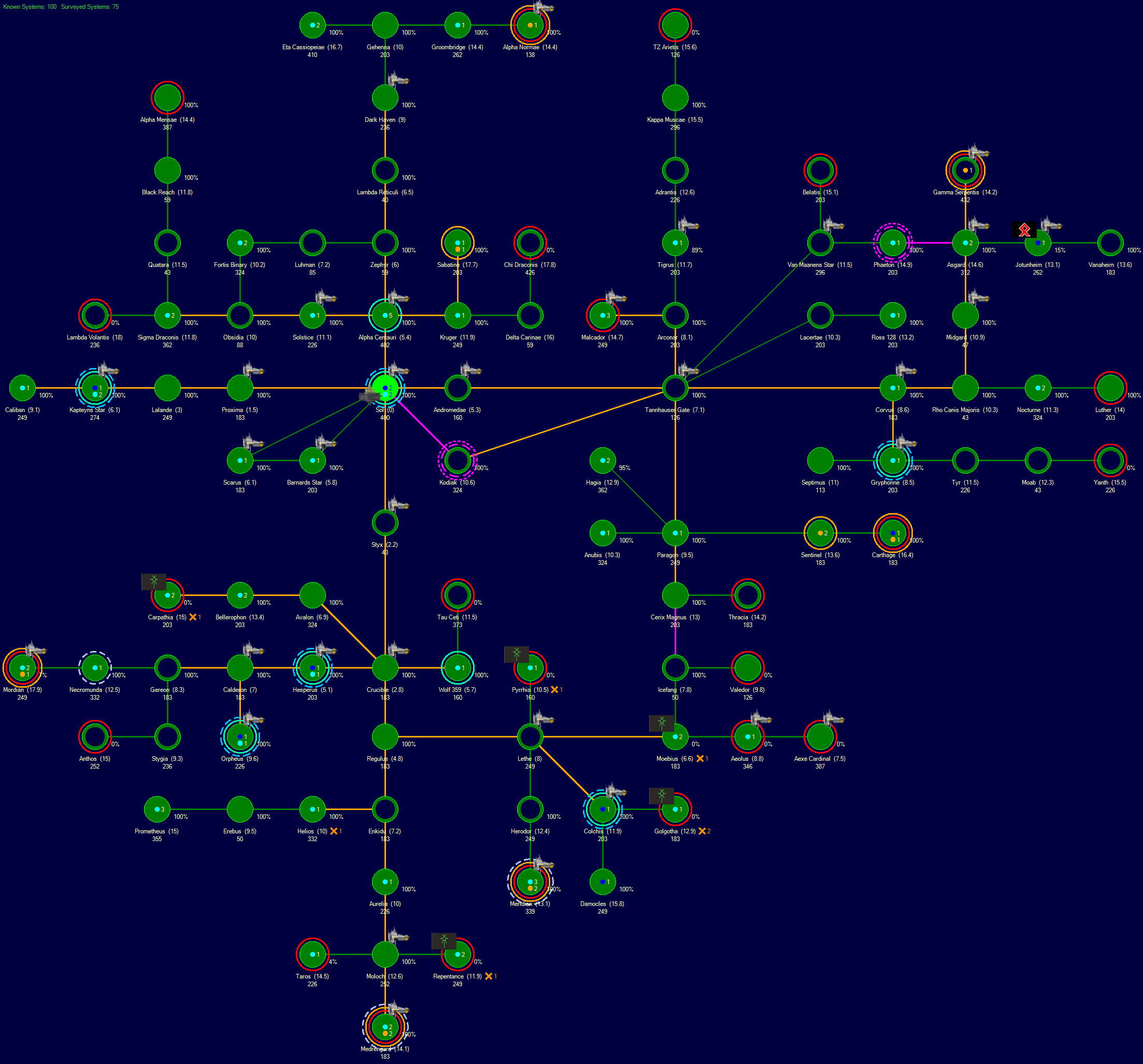
Aexe Cardinal was a young system, two transits beyond the Necron system of Moebius, with seven planets, twelve moons and three hundred and forty-two asteroids. Two survey ships were assigned, as the combination of the system age with the large amount of real estate had the potential to yield valuable mineral resources. Aexe Cardinal I, a Venusian world, was the first body to be surveyed. In addition to extensive deposits of numerous mineral deposits at medium accessibility, it had a high chance of a ground survey improving those results.
Aexe Cardinal I Survey ReportDuranium: 3,553,778 0.70
Neutronium: 216,225 1.00
Corbomite: 6,620,329 0.50
Boronide: 2,907,025 0.30
Mercassium: 4,060,225 0.10
Vendarite: 984,064 0.40
Uridium: 753,424 0.80
Corundium: 15,376 0.40
Gallicite: 1,177,225 0.70
This early indication was a sign that the system had to be secured, so the first offensive military operation of the Imperium was launched to remove the Necrons from the Moebius system. Both Gothic-B class cruisers, three Dauntless II-B light cruisers and both Defiant class carriers were dispatched to Colchis Base, an asteroid in the Colchis system that had large, accessible mineral deposits and was massive enough to support an atmosphere. The asteroid was in the final stages of terraforming and already had a population over twelve million, plus extensive orbital basing facilities capable of supporting the Imperial Expeditionary Force. Colchis Base was within striking range of three Necron systems, including Moebius, making it an ideal forward operating base.
First Expeditionary FleetGothic-B class Cruiser:
Imperial Wrath, Righteous FuryDauntless II-B class Light Cruiser:
Divine Crusade, Ravenor, Vengeful MartyrDefiant-B class Light Carrier:
Archangel, Defiant2x Thunderhawk class Assault Transport:
4x Aquila IV class Scout:
24x Starhawk-B class Bomber:
24x Fury-B class Interceptor:
The Expeditionary Force entered Moebius, paused at two hundred million kilometres and dispatched an Aquila scout to check the second planet, the location of the previously detected Necron forces, then changed course to investigate Moebius III, a gas giant with twenty-four moons. The fleet confirmed the lack of any alien presence at the gas giant and set course for the second planet, with the small scout just thirty million kilometres from the same destination, approaching without active sensors. Unfortunately, that was not enough to avoid detection and the scout’s passive sensors detected inbound torpedoes. The Aquila engaged active sensors just before they hit but detected nothing else within its fifteen million kilometre range. The salvo comprised ten size-9 torpedoes with strength-7 warheads travelling at 34,555 km/s, sufficient to blow the 500-ton scout into very tiny pieces.
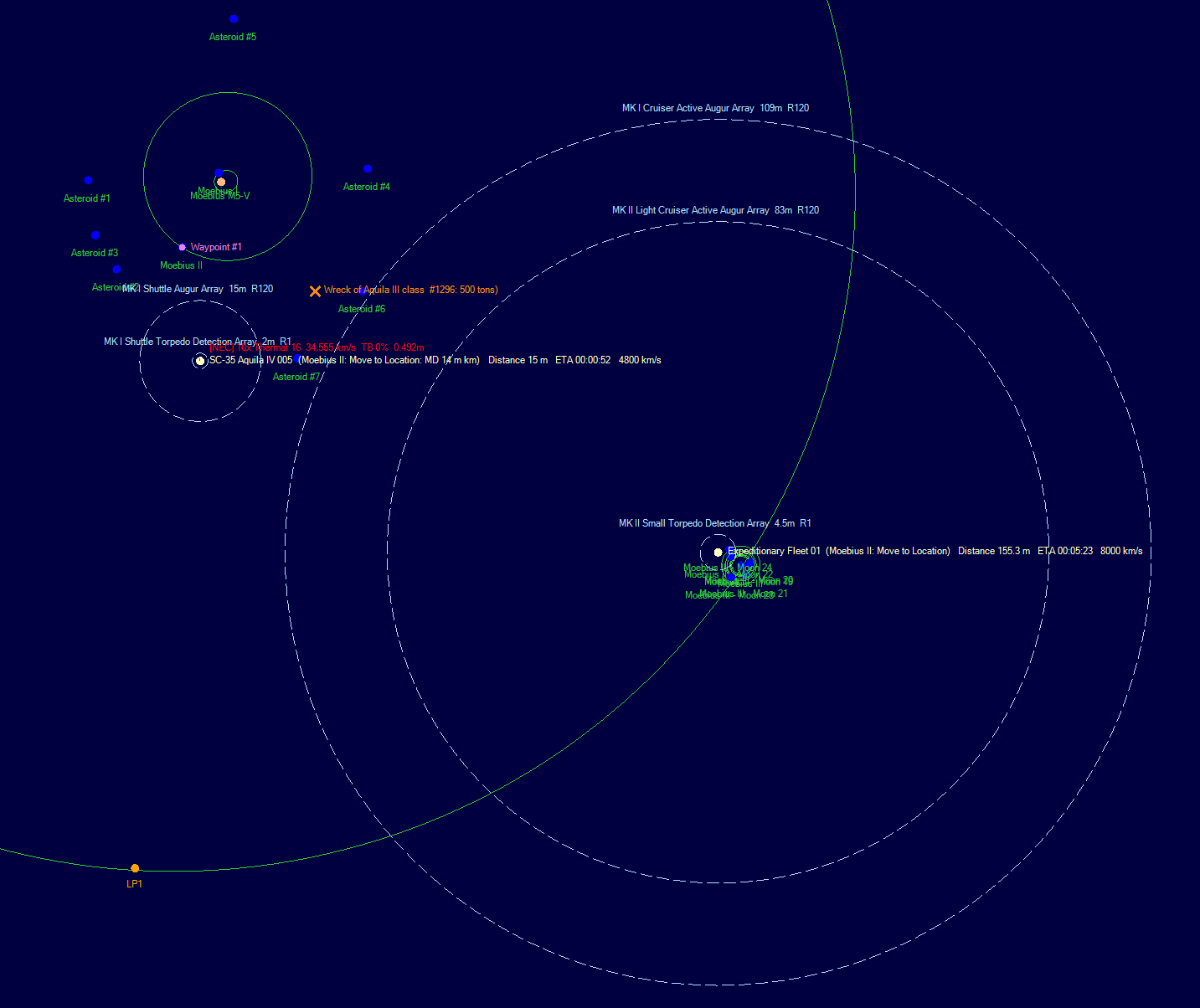
The Expeditionary Force closed on the second planet and detected the same ships as the Starhawk-R mission four years earlier. A 19,164 ton Scythe class, Shroud, Cartouche and Khopesh class ships of 9,590 tons and a dozen Mephrit class ships of 979 tons. At fifty-two million kilometres, the fleet was attacked by a single salvo of ten torpedoes. The fleet used its eighty-four AK-10 weapon batteries for point defence, which resulted in massive overkill on nine torpedoes, but the tenth slipped through and impacted the shields of Imperial Wrath.
Further salvos of ten torpedoes arrived approximately ten minutes apart, with only occasional hits, then pairs of salvos which accomplished the same. A single salvo of forty-eight torpedoes, travelling at 51,844 km/s and estimated to be from the Mephrit class ships, caused more concern, so the fleet’s twenty-four Fury class interceptors were launched to provide additional point defence. Thirty-one inbounds were killed by the fleet’s AK-10 weapon batteries, four by the larger AK-25s and seven by the Furies. Four more missed, leaving just two to expend themselves on the shields of Imperial Wrath. Further salvos of ten continued to arrive in pairs five seconds apart, but posed no real threat. The Expeditionary Force moved within three million kilometres of the planet and detected a ground force signature of 22,000 tons, which probably represented a much larger force after accounting for fortifications.
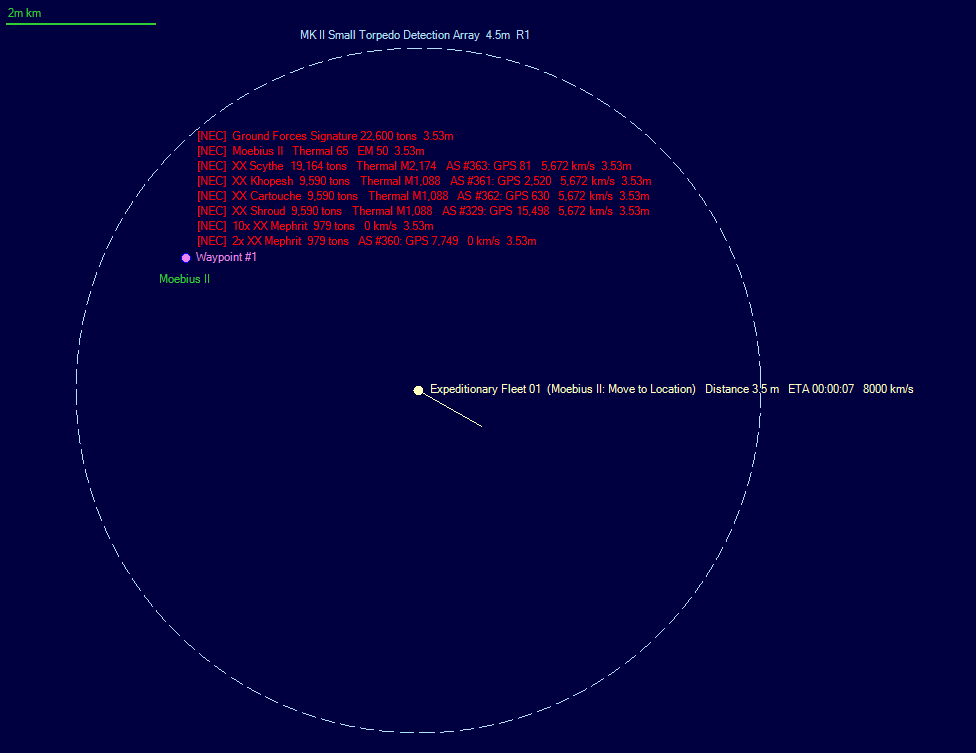
At one point two million kilometres, the Expeditionary Force came under attack from waves of thirty-two small torpedoes with strength-1 warheads, travelling at 77,200 km/s and arriving every ten seconds. Despite the Furies bolstering the fleet’s point defence once again, several torpedoes from each wave impacted the shields of either Righteous Fury or the carrier Defiant. The Starhawks were launched and ordered to target the largest enemy ship, designated as Scythe class, with a wave of forty-eight MK II-B Standard Torpedoes. Once the Starhawks coordinated their targeting and launched, the Necron torpedo waves began attacking the Imperial torpedoes. The range to the planet was 800,000 km.
Thirty-nine of the Starhawks’ torpedoes detonated, but twenty-eight of those hits decoys. Ten strength-15 warheads were not sufficient to penetrate the Scythe’s armour. The Starhawks landed and began to re-arm, although that process would take too long to affect the battle further. The Necron light torpedoes started to engage the Expeditionary Force once more, but the Imperial attack had disrupted the coordination of the waves and they now arrived in alternative salvos of twenty and twelve, posing no significant threat.
370,000 kilometres from the planet, the cruiser Righteous Fury came under attack from surface-based energy weapons, estimated to be large bombardment cannons. All thirteen shots missed. The Defiant class carriers and their escorting Furies were ordered to pull back to 500,000 km while the other five ships continued onward. At 250,000 km, four of the five Imperial warships opened fire at with weapon batteries, inflicting multiple armour hits on the four larger Necron ships. Righteous Fury bombarded the planet, trying to eliminate the surface-based batteries. Five seconds later, at 210,000 km, they followed up with lance batteries, penetrating armour on two ships, then held position at that range to avoid getting too close to the STO batteries.
The second volley from the Imperial ships penetrated the armour of all the Necron ships. A massive strength-118 secondary explosion destroyed the Cartouche; the first alien kill for Imperial Wrath and the Imperium and the beginning of humanity’s revenge. The cruiser joined her sister ship in bombarding the planet. Meanwhile, the twelve small Mephrits broke orbit and ran, while the other Necron ships charged the Expeditionary Force
The surface-based bombardment cannon fired again, inflicting four strength-8 hits on Righteous Fury, which destroyed four of them when she returned fire. The Imperial ships continued to hold their position and pounded the approaching Necrons. The Khopesh and Shroud were both disabled, followed by the larger Scythe. All fire was directed against the planet, while the fleet’s two Thunderhawks and their space marines were dispatched to board the crippled alien ships.
The end of the brief engagement was in sight. The last of the STO weapons were eliminated, while the marines boarded and captured the Scythe – an escort design with thirty-two light torpedo launchers. The Fury class interceptors were dispatched to run down and destroy the fleeing Mephrits while the marines boarded their Thunderhawks and assaulted the two smaller disabled ships.
Scythe class Escort Cruiser 19,164 tons 384 Crew 3,063.6 BP TCS 383 TH 2,176 EM 0
5677 km/s Armour 6-63 Shields 0-0 HTK 115 Sensors 0/0/0/0 DCR 8-4 PPV 32
Maint Life 0.85 Years MSP 799 AFR 367% IFR 5.1% 1YR 937 5YR 14,061 Max Repair 520.6 MSP
Magazine 1,723 / 144
Captain Control Rating 2 BRG CIC
Intended Deployment Time: 12 months Morale Check Required
Magneto-plasma Drive EP544 (4) Power 2176 Fuel Use 27.12% Signature 544 Explosion 10%
Fuel Capacity 750,000 Litres Range 26 billion km (52 days at full power)
Size 24 Decoy Launcher (6) Decoy Size: 24 Hangar Reload 245 minutes MF Reload 40 hours
Size 1 Missile Launcher (32) Missile Size: 1 Rate of Fire 10
Missile Fire Control FC19-R1 (7) Range 19.6m km Resolution 1 ECCM-2
Active Search Sensor AS16-R1 (1) GPS 82 Range 16.9m km MCR 1.5m km Resolution 1
Electronic Warfare Jammers: Sensor 2 Fire Control 2 Missile 2
The Imperium warships moved toward the planet to check for any shorter-ranged surface defences. At 90,000 km, Righteous Fury suffered a single strength-20 hit. Six other shots missed. The ships pulled back and opened fire, quickly eliminating the new threat. The fleet moved closer once again, this time without incident. The next phase would be to land Imperium troops to eliminate the remaining Necron ground forces.
Due to the Imperium focus on building its economy, the ground forces had been neglected, apart from the various Ordo formations and planetary defence regiments. Only six armoured formations with a total of six hundred Leman Russ battle tanks, were available. Each tank was 104 tons. On May 22nd 4026, they were landed on Moebius II by three Orca class troop transports. Losses were heavy and immediate. The alien forces comprised a large amount of robotic infantry supported by hundreds of larger Mech-type units with similar capabilities to the Imperium tanks, but utilising superior technology. An evacuation was ordered and half the original assault force made it back to the ships. To their credit, they managed to destroy almost forty percent of the Necron defenders. Meanwhile, an orbital survey revealed a ruined colony on the surface, apparently guarded by the Necrons. Perhaps the ruins of another fallen civilization from two thousand years ago.
A second invasion was launched several months later that included the survivors of the first assault plus four new armoured regiments with improved armour and weapons. This time there was no retreat. Thirteen days after the landing, all enemy forces had been eliminated. Losses were significantly lower than the first attack. There were no alien installations on the surface, but it was now clear for the Ordo Xenos to survey the ruins.
In November 4026, a second operation was launched, this time against the Necrons in Golgotha. This was undertaken by the same Imperial Navy fleet, with the exception of the light cruiser Divine Crusade, which was still covering the ongoing activity in Moebius. The known Necron forces comprised three Triarch class frigates armed with 25cm bombardment cannon, a pair of similarly sized Crypteks of unknown capability, two larger ships, a Dirge and a Deathmark – also never previously encountered, and a dozen Mephrit fast attack craft, each armed with four single-shot torpedo launchers.
Expeditionary Fleet Gothic-B class Cruiser:
Imperial Wrath, Righteous FuryDauntless II-B class Light Cruiser:
Ravenor, Vengeful MartyrDefiant-B class Light Carrier:
Archangel, Defiant2x Thunderhawk class Assault Transport:
3x Aquila IV class Scout:
24x Starhawk-B class Bomber:
24x Fury-B class Interceptor:
Necron Forces in Golgotha1x Dirge 19,271 tons
1x Deathmark 19,212 tons
3x FF Triarch 9,553 ton, 5,686 km/s, 5x 25cm Bombardment Cannons
2x Cryptek 9,567 tons, 5,686 km/s.
12x Mephrit 979 tons.
This time there was no long-range torpedo fire, apart from a single salvo from the Mephrits. When the Expeditionary Fleet moved within one point two million kilometres of the planet, it came under attack from waves of sixty-nine light torpedoes, with a speed of 77,200 km/s. The Furies were deployed to improve point defence coverage and the Starhawk class bombers were ordered to conduct an attack on the Deathmark to distract the defenders. While the Starhawks were still coordinating their launch, the Necrons changed targeting to the bombers.
The first Starhawk exploded just as the Imperium torpedoes were launched, but they had to remain on station to provide guidance for their own torpedoes. Four were destroyed and several other damaged before they could return to the relative safety of their hangar bays. Twenty-two of the MK II-B Standard Torpedoes reached the Deathmark. Nine avoided the decoys and struck the target, with two penetrating the armour. As with the Imperial torpedo launch in Moebius, the attack also disrupted the Necron launches, reducing the effect of the large waves of light torpedoes.
The carriers and the Furies were detached at half a million kilometres as the four Imperial warships approached the planet. They came under attack from the surface and from the Triarchs, while still fending off light torpedoes, but their superior firepower was decisive. Once the alien ships began taking damage, the smaller ships ran – except for one damaged Triarch that charged the Imperial squadron. The Dirge and Deathmark appeared to be orbital bases, with the Dirge being the source of the light torpedoes. The Imperial warships blasted the bases into scrap metal, disabled the approaching frigate, then circled around the planet to chase the other four ships, while focusing their fire on the surface batteries. By the time the battle ended, the three Triarchs had all been disabled and captured, the STOs had been eliminated and every other Necron ship destroyed.
In December, a survey of Golgotha revealed a ruined city and a large ancient construct, believed to be research-related, although a ground survey by the Ordo Xenos would be needed to confirm. In Moebius the survey had been completed, revealing sixty-seven locations of interest that could yield recoverable installations or supplies.
At the end of the month, the first Imperial warship to be completed in several years was launched: the Defiant class light carrier Imperial Ghost. All further construction had been delayed due to the imminent availability of several new technologies, including larger and longer-ranged weapon batteries, new shield generators, faster-charging capacitors, better sensors and improved fuel consumption. Shipyards would be begin retooling with the next generation of warship designs at some point in 4027, with the first new ships laid down in 4028. The changes were so extensive that the existing fleet would not be refitted.
On April 22nd 4027, the invasion of Golgotha II was launched with eight armoured regiments, comprising three hundred Leman Russ battle tanks and five hundred Leman Russ MK IIs, roughly the same force that triumphed in the Second Battle of Moebius Unfortunately, the lessons of the first Moebius invasion had not been learned. The Necron forces on Golgotha II were significantly stronger than the original Moebius garrison and the invasion was a disaster. Four hundred tanks were lost before the survivors were evacuated, with the Necrons losing around ten percent of their force. It would take considerable time to build up for a new invasion.
The situation became even worse for the Imperium on February 8th 2028. The diplomatic station and Daedalus class intelligence ship in orbit of Jotunheim II were destroyed in an surprise attack by the Jotun. Communication had not been established and the Jotun seemed reluctant to engage, but there was no threat of hostilities beyond an occasional unintelligible message. The attacking ship was a 64,755 ton Midgard class cruiser, armed with forty-nine 20cm lasers plus a spinal laser and moving at speed of 5396 km/s. Eight Midgards had been identified, which gave the Jotun a 4-1 advantage in cruiser-sized warships, although their technology appeared to be less advanced. The attacking Midgard was accompanied by Hrothgar class ships of 44,000 tons, which also had military engines but did not open fire. Ten Hrothgars were known to be in service. This meant war. The cowardly and duplicitous Jotun would be destroyed and their resources used to fuel the Imperial war machine.
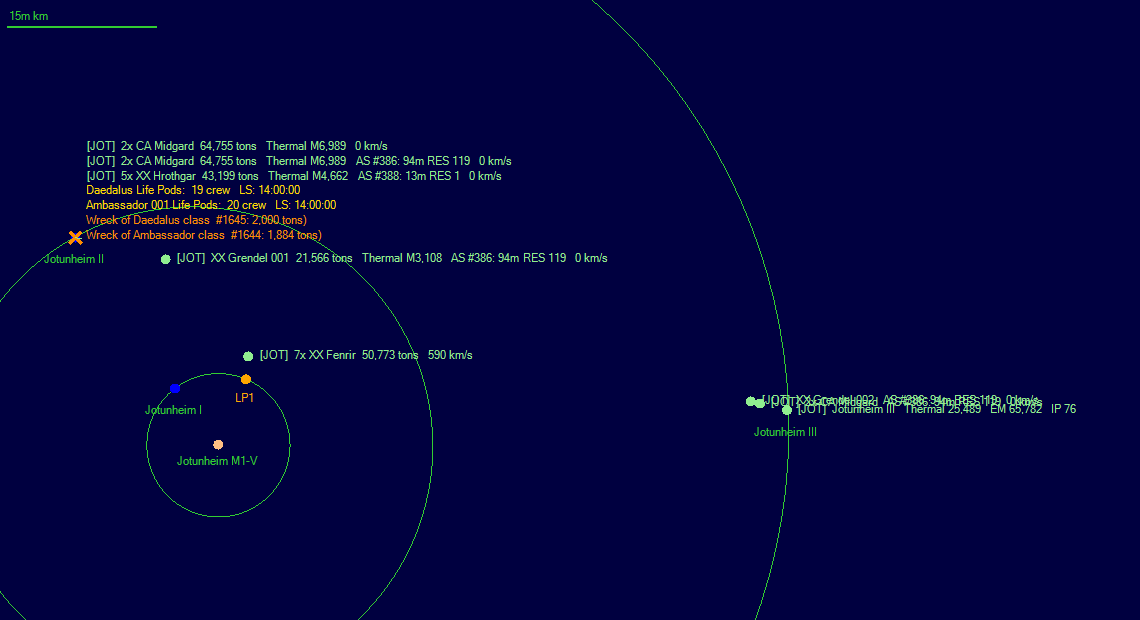
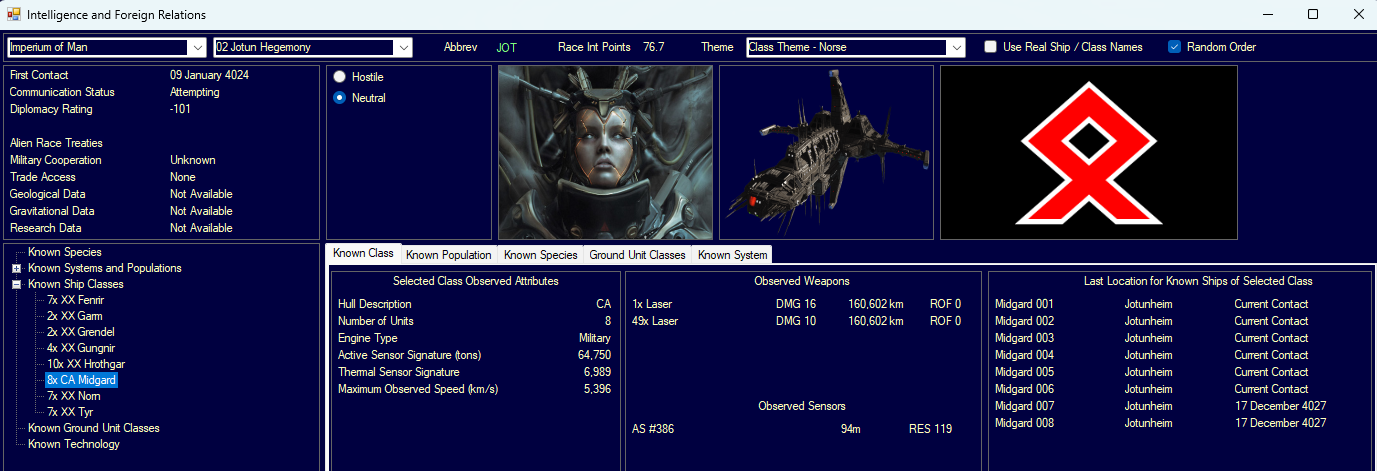


 Recent Posts
Recent Posts




